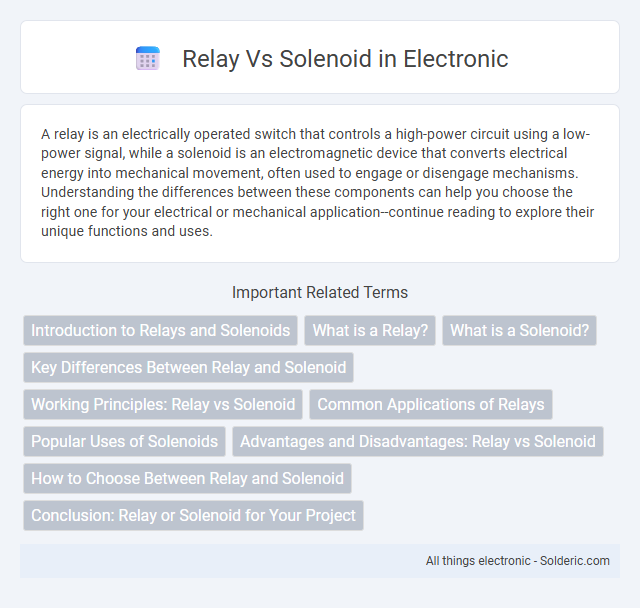A relay is an electrically operated switch that controls a high-power circuit using a low-power signal, while a solenoid is an electromagnetic device that converts electrical energy into mechanical movement, often used to engage or disengage mechanisms. Understanding the differences between these components can help you choose the right one for your electrical or mechanical application--continue reading to explore their unique functions and uses.
Comparison Table
| Feature | Relay | Solenoid |
|---|---|---|
| Function | Electromechanical switch for controlling circuits | Electromechanical actuator converting electrical energy into linear motion |
| Primary Use | Switching electrical loads remotely | Operating valves, locks, or mechanical devices |
| Operation Type | Switch contacts open/close electrical circuit | Plunger movement creates mechanical action |
| Voltage Range | Low to high, depending on coil and contacts | Typically low voltage DC, varies by application |
| Current Handling | Up to several amperes for contact load | Depends on solenoid design; often higher inrush current |
| Response Time | Milliseconds to tens of milliseconds | Milliseconds to hundreds of milliseconds |
| Mechanical Movement | Contact toggling without major motion | Linear plunger movement for actuation |
| Applications | Automotive, industrial control, signal switching | Door locks, pinball machines, hydraulic valves |
| Power Consumption | Low coil power, varies with relay type | Higher power due to mechanical actuation force |
Introduction to Relays and Solenoids
Relays and solenoids are essential electromechanical components widely used in automation and control systems. A relay functions as an electrically operated switch, allowing low-power signals to control high-power circuits, while a solenoid converts electrical energy into linear mechanical motion for actuating valves or locking mechanisms. Understanding the distinct roles of these devices helps optimize your system's performance and reliability.
What is a Relay?
A relay is an electrically operated switch that allows a low-power circuit to control a high-power circuit by using an electromagnet to mechanically operate the switch contacts. It enables isolation between control and controlled circuits, protecting sensitive components from high voltage or current. Relays are commonly used in automotive, industrial automation, and electronic control systems for signal switching and circuit protection.
What is a Solenoid?
A solenoid is an electromechanical device that converts electrical energy into linear motion by creating a magnetic field when current passes through its coil. Commonly used in automotive starters, locking mechanisms, and industrial machinery, solenoids provide precise control over mechanical movement with rapid response times. Your choice between a relay and a solenoid depends on whether you need an electrical switch or a device to actuate physical motion.
Key Differences Between Relay and Solenoid
Relays control electrical circuits by opening or closing contacts using an electromagnetic coil, while solenoids convert electrical energy into linear mechanical motion for actuating valves or locks. Relays primarily manage signal switching without significant mechanical movement, whereas solenoids produce physical movement to perform mechanical work. The key difference lies in function: relay as an electrical switch, solenoid as an electromechanical actuator.
Working Principles: Relay vs Solenoid
Relays operate through an electromagnetic coil that, when energized, creates a magnetic field to mechanically move a set of contacts, allowing electrical circuits to be opened or closed. Solenoids function by converting electrical energy into linear mechanical motion via an electromagnetic coil, which pulls or pushes a plunger to perform tasks such as activating valves or locking mechanisms. Unlike relays that primarily switch electrical circuits, solenoids provide direct mechanical action for physical movement in various automation applications.
Common Applications of Relays
Relays are widely used in industrial automation systems, motor control circuits, and home appliance controls due to their ability to switch high-power devices with low-power signals. They serve crucial roles in electrical isolation and signal amplification, making them ideal for applications such as lighting control, HVAC systems, and automotive electronics. Understanding these common applications helps you select the right relay for reliable and efficient operation in your electronic projects.
Popular Uses of Solenoids
Solenoids are commonly used in automotive starters, door locking mechanisms, and industrial machinery for precise linear motion control. Their ability to convert electrical energy into mechanical movement makes them ideal for applications requiring fast, reliable actuation. You can find solenoids in vending machines, pneumatic valves, and robotics for efficient switching and control tasks.
Advantages and Disadvantages: Relay vs Solenoid
Relays offer the advantage of electrically isolating control circuits from high-power loads, providing reliable switching with low power consumption and fast response times. Solenoids excel in converting electrical energy into mechanical motion, making them ideal for applications requiring precise linear movement or actuation, but they consume more power and generate heat during operation. Your choice between a relay and solenoid should consider whether electrical switching or mechanical movement is the primary function needed, balancing energy efficiency, control complexity, and application requirements.
How to Choose Between Relay and Solenoid
Choosing between a relay and a solenoid depends primarily on the application requirements and load characteristics. Relays are ideal for switching electrical circuits with low to moderate current loads, providing electrical isolation and control via a small input current. Solenoids function as electromechanical actuators, converting electrical energy into linear motion, making them suitable for mechanical operations like valve actuations or locking mechanisms.
Conclusion: Relay or Solenoid for Your Project
Relays excel in controlling multiple circuits with low power signals, offering versatility in various electronic applications, while solenoids provide precise mechanical movement ideal for actuation tasks requiring linear motion. Choosing between a relay or solenoid depends on whether your project prioritizes electrical switching capabilities or mechanical force generation. For projects demanding circuit control and isolation, relays are optimal; for tasks involving physical motion, solenoids deliver efficient performance.
relay vs solenoid Infographic

 solderic.com
solderic.com